Basic Terms
Adaptation
Not original content but based on an already existing work (light novel, anime, picture book etc.). Example: Josee, the Tiger and the Fish which was a Light Novel adaptation.
Mangaka
Mangaka means the artist of the manga. Mangaka can also be the story writer. Generally, mangaka does everything by himself, but sometimes he may employ assistants to speed up the work and cope with the weekly release schedule.
Origin
| Comics | Country |
|---|---|
| Manga | Japan |
| Manhwa | Korea |
| Manhua | China |
| Manfra | France |
| OEL | English-speaking countries |
| Komik | Indonesia |
Sound Effects
Sound effects in manga visualizes the character's physical or mental state, the environment of the scenario, motions or just sounds (obviously). Here is a collection of Japanese Sound effects.

Example
In the sfx image you can see the parallel lines at the tops. These are symbols; works like sfx. These symbols may be used with or without sfx. They can have multiple meanings depending on the context. Like in the next image, it means shock.

Panel Terms
General
| Type | Manga | Manhwa | Manhua |
|---|---|---|---|
| Direction | Right to Left | Left to Right | Left to Right |
The usual reading direction for manga is right to left, whereas manhwa and manhua are read left to right (like standard comics). In the case of manga, the individual panels are read right to left and top to bottom, then top again upon reaching the next page.
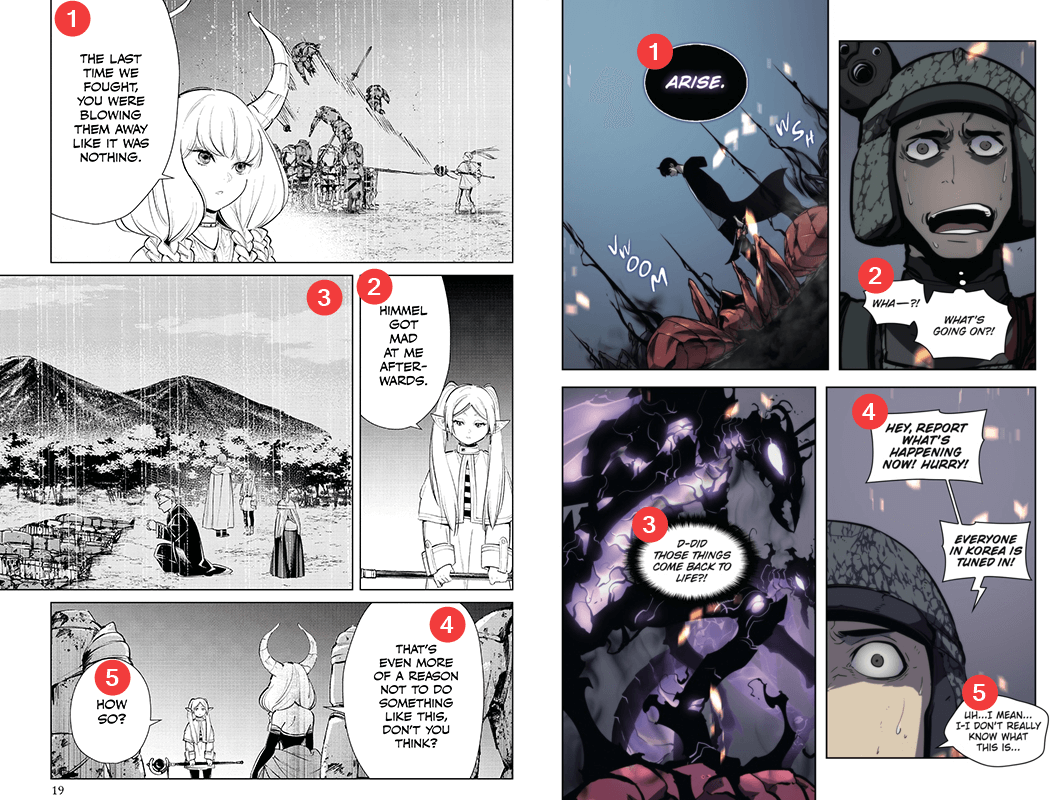
For a spread, you can set an imaginary line based on the page number.
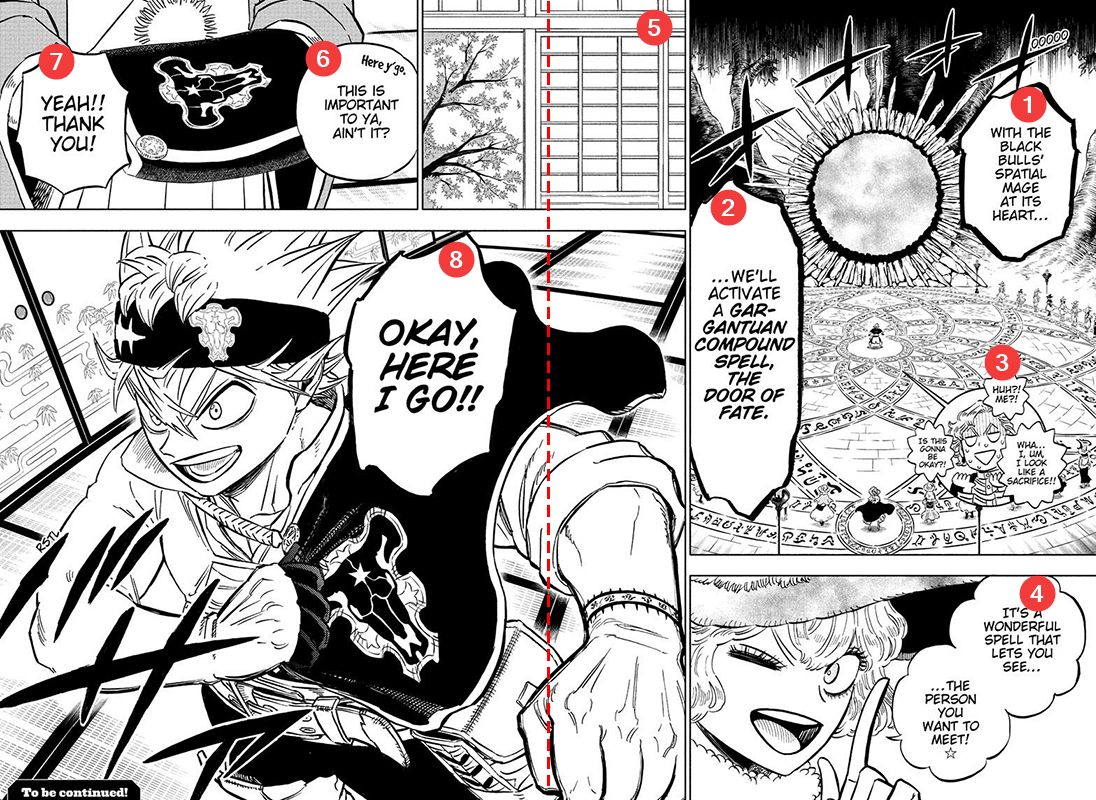
4-Koma
4-Koma (a.k.a. Yonkoma manga) features four panels and follows a specific pattern where every four panels lead up to a punchline. These are generally read up-down instead of the traditional right-left. The right column is always the starting column. It can be a single column or a double column. For some manga or omake, it may follow right to left a.k.a. the traditional way.
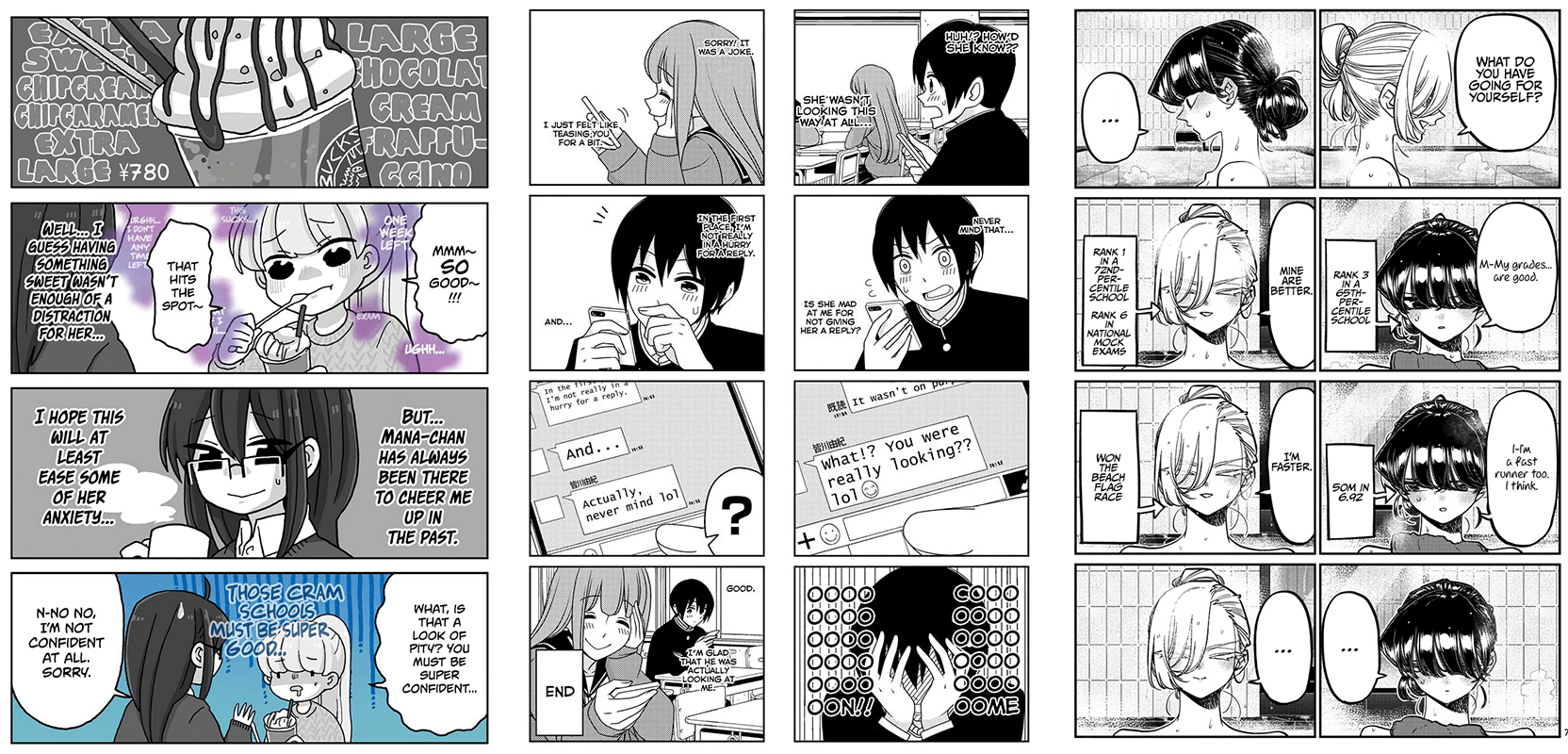
To easily understand the reading order, you can look for the space between rows or columns. If the column has more space, then it's up to down. If otherwise, then right to left.
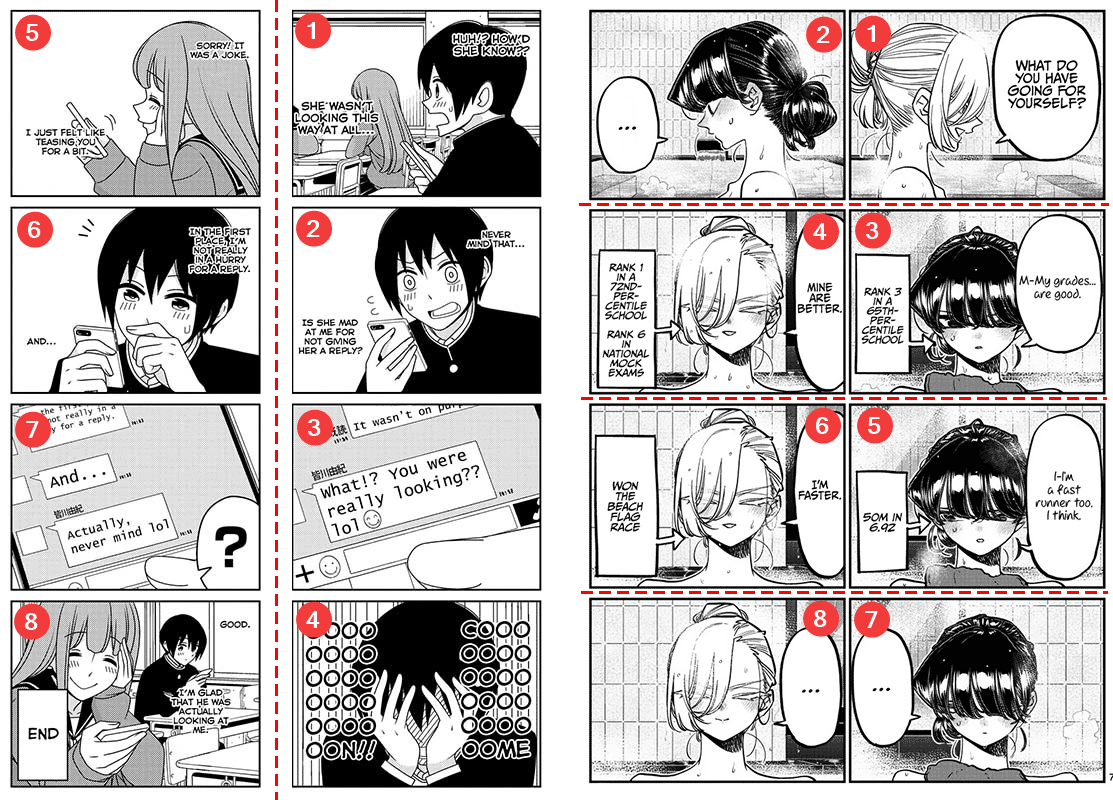
Occasionally, panel sizes or column gaps may exhibit variations, resulting in a change in the reading direction.
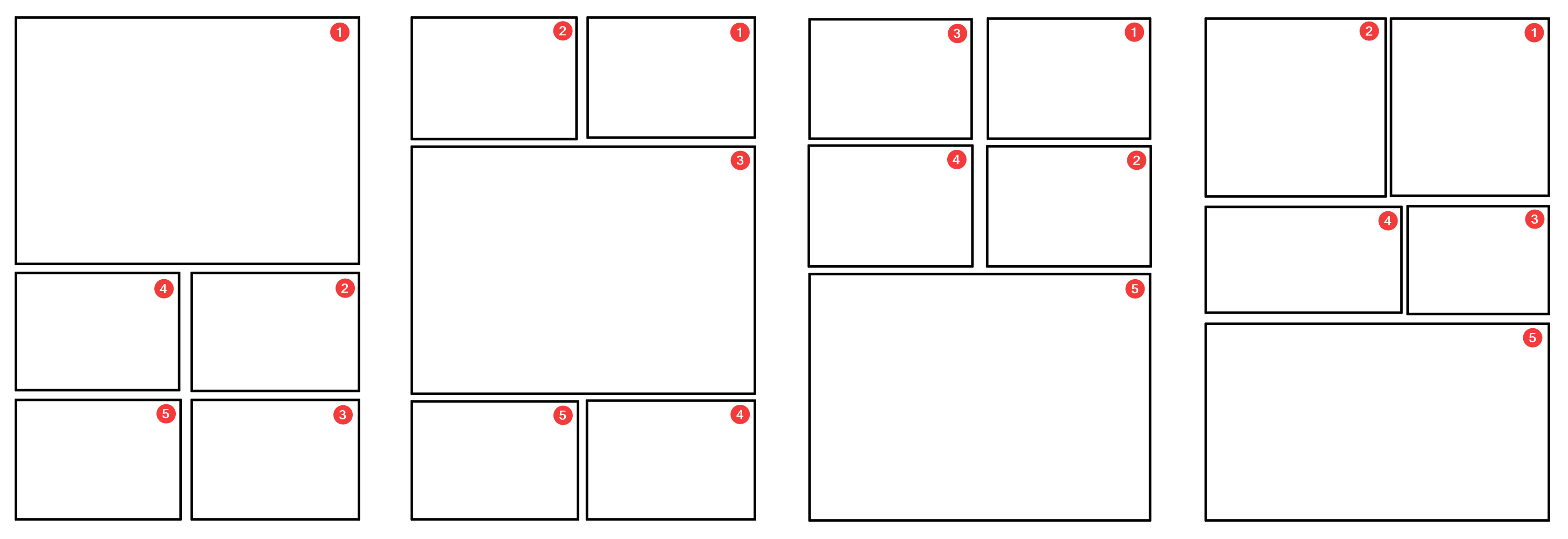
At times, the beginning of a 4-Koma manga may feature a sizable illustration, spanning either half the page vertically or horizontally.
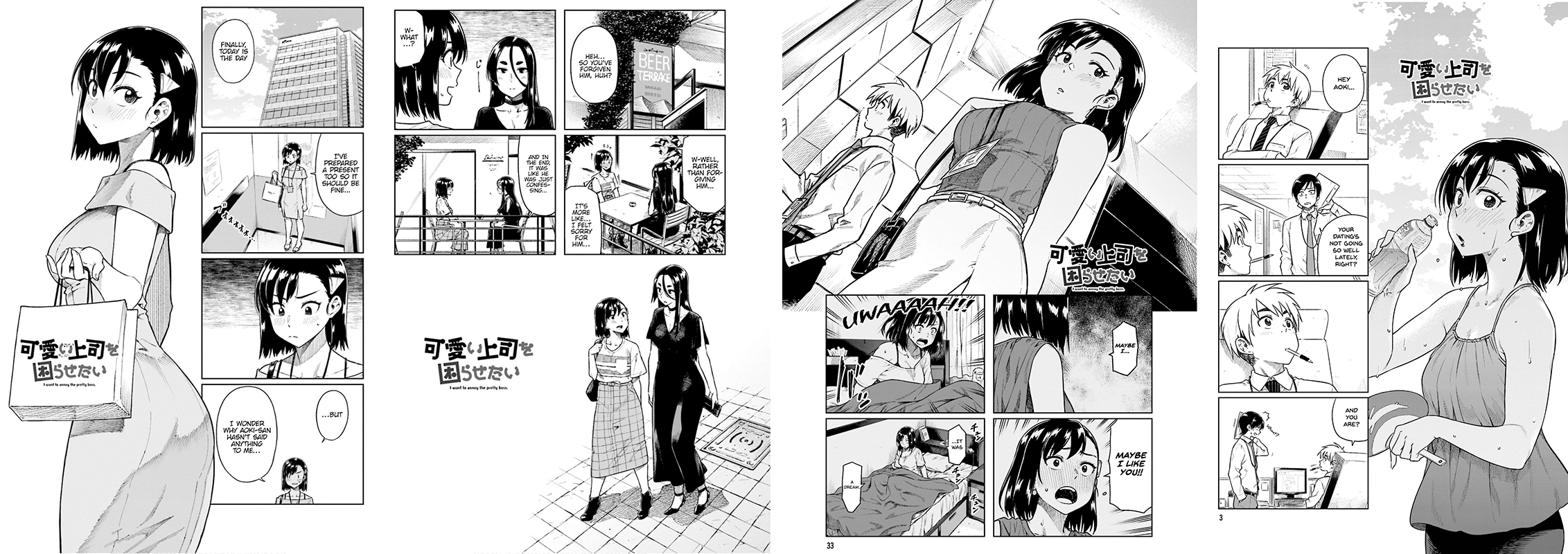
Long strip
It's a newer type of comics format. Long strip comics are drawn for smartphone readers. The flow of the panels is up-down instead of traditional right-left/left-right. For long strip comics, the artist has to follow different rules than in the traditional manga format. This format is widely used in the manhwa and manhua industries. But it's available for every region. Example: Solo Leveling (Manhwa), Relife (Manga), The Beginning After the End (OEL).
Occasionally, the publisher also releases the physical version, with panels strategically rearranged to accommodate the right-left/left-right reading direction. Example: Solo Leveling Vol. 2 by Yen Press
Splash
A splash page is a single panel that covers the entire page and is typically reserved for depicting an action-packed or dramatic scene.
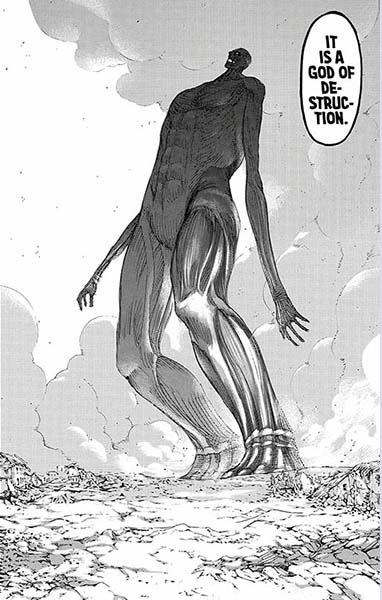
Spread
A panel/artwork that is spread out over two pages, reserved for particularly impactful moments.
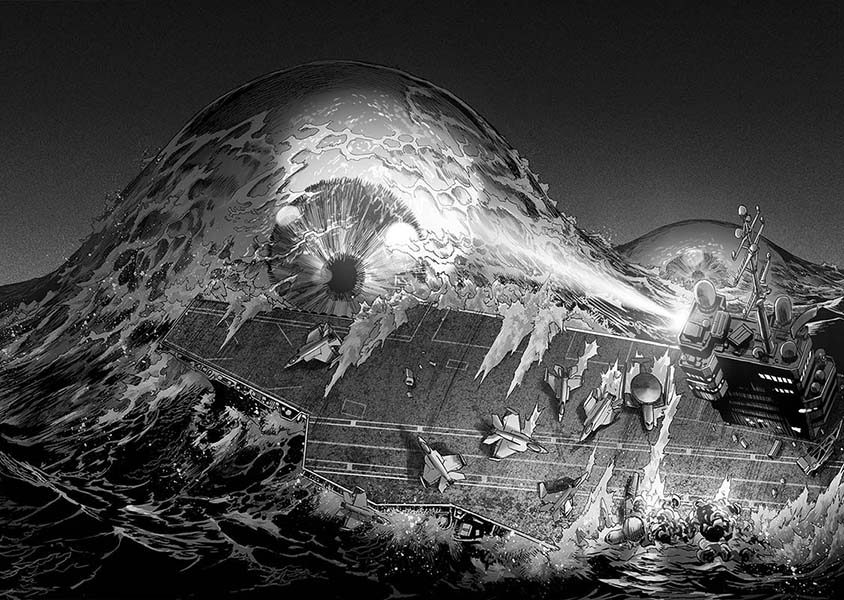
Another type of spread where the panel covers more than one page, but not the whole two pages.
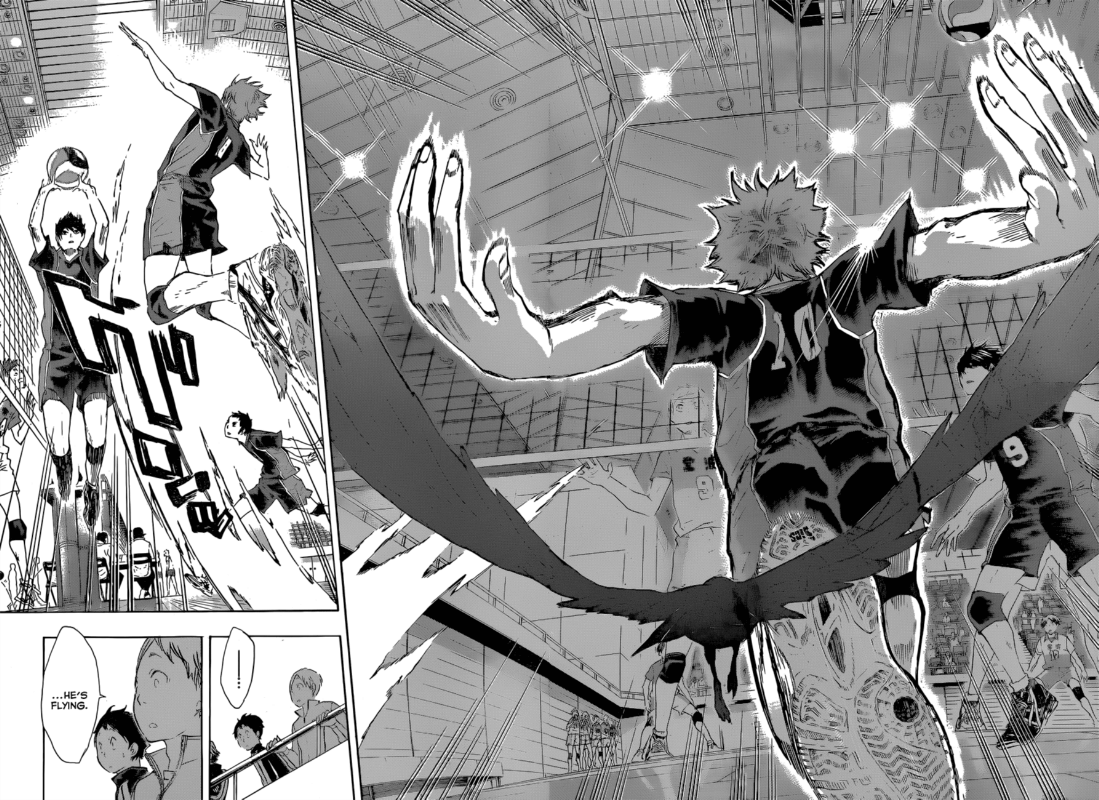
They can sometimes cover multiple pages, which is solved by having fold-outs.

Release Terms
Backfilling
When the translation of a series starts with the latest chapters, with the publisher later working on the rest, starting from the beginning.
Doujinshi
Doujinshi refers to self-published works. It can be a standalone self-published work, but it can also be a derivative of an existing published franchise or work. Doujinshi need not be NSFW, anything self-published counts.
Sometimes, mangaka publish their work as a doujin before an official serialization. Example: Ganbare, Douki-chan (Pre-serialization). Sometimes after the serialization has ended. Example: Mangaka-sensei and the Zashiki Warashi (post ch. 29)
OEL Comics
OEL, or Original English-language comics, originate in English-speaking countries. They prominently feature Asian cultural influences in their art styles, themes, and storytelling, while the creators, including artists and production, are primarily non-Asian. Prominent examples include Bizenghast, Attack on Titan Anthology, Ghost in the Shell: Global Neural Network and The Beginning After the End.
Omake
A bonus/extra chapter that doesn't really affect the main story. Generally it gives artworks, character backgrounds, mangaka notes or an extra story.
Omnibus
A release type characteristic of western publishers where multiple tankoubon volumes are contained in one book. It's most commonly seen as 2-in-1 or 3-in-1 editions, tho it can sometimes contain an entire series, like in the case of the Death Note All-in-One volume. They're usually larger format and can contain extras, especially if the series already had a tankoubon release previously.

One-Shot
A manga that's been published at once. The length of the story depends on the mangaka. Also, it can be serialized later. Example: Kimi no Kaketeru Tokomo Suki
Raw
The term 'RAW' refers to manga (Japan), manhwa (Korea), or manhua (China) that has not been modified in any way from its original form. It can be both physical (scanned) or digital (ripped). Nowadays most of the raws are digital.

Simulpub
Simultaneous publication, meaning releasing and translating the latest chapters alongside their country of origin.
Tankoubon
Tankoubon means the volume release. Many manga are initially published in magazines such as Weekly Shonen Jump. If a manga becomes very popular, it can receive a volume release a.k.a. Tankoubon. These volumes often include redrawn content, extra chapters, and notes from the mangaka. Sometimes, Tankoubon collections can feature various works by the mangaka, similar to an anthology.
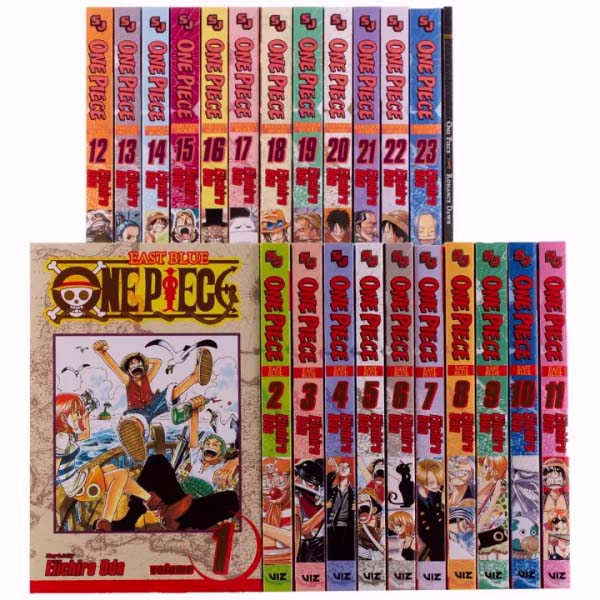
Other volume types
| Term | Meaning |
|---|---|
| Aizouban ("loving collection edition") | Collector's edition volumes, usually printed in limited runs. These volumes are generally more expensive and come with special features such as new covers, higher-quality paper, a special slipcase, etc. |
| Bunkoban ("paperback edition") | A volume printed in bunko format, or a typical Japanese novel-sized volume. Generally A6 size and thicker than tankoubon, usually with new covers. Bunkoban tends to contain considerably more pages than a tankoubon, meaning the bunko edition of a given manga will consist of fewer volumes. |
| Goukaaizouban ("luxury favorite edition") | Another term occasionally used to designate a type of special release. |
| Kanzenban ("perfect complete edition") | A special complete edition. Volumes are generally A5 size and will typically include individual chapter covers, color pages, and side-stories from its original magazine run, all of which are often omitted or converted to grayscale in standard tankoubon releases. |
| Shinsouban ("new decoration edition") | A new edition, usually with special covers, new color pages and other extras. They can even feature completely redrawn pages and rewritten dialogue. |
| Soushuuhen ("complete collection") | A format published by Shueisha beginning in 2008. Volumes are B5 size, larger than a kanzenban. They include chapter covers, color pages, and various bonus features such as posters and interviews. They're usually reserved for popular manga with ongoing serializations and contain far more pages than a standard tankoubon, thus feature more chapters in fewer volumes. |
| Wide-ban | A larger (A5 size) edition. Many manga, particularly seinen and josei, are published in wide-ban editions after magazine serialization, and are never released in the tankoubon format that is common in shounen and shoujo manga. When a series is originally published in tankoubon format and then re-released in wide-ban, each volume will contain more pages than the original edition, thus consisting of fewer volumes. |
Webcomic/Webmanga
Was originally published on a web platform. The platform can be free(twitter, pixiv etc) or paid (Comico, comic-walker etc.). Example: ReLife (comico) & A Story About Smoking at the Back of the Supermarket (twitter)
Scanlation
Scanlator
A group that fan translate a manga/manhwa/manhua. The group takes the raw file and translate the whole manga (including dialogue, sfx & other forms of text). Also, sometimes the wordplays & cultural references provided in that chapter are explained in the credit section.
Cleaner (CL)
Cleaner takes the raw file, fixes any faults (such as artifacts due to scanning, color shifts, tilts, etc.), and cleans all of the original text including SFX, if necessary. But these days, this can be only removing texts since digital raw is widely available.
Redrawer (RD)
Redrawer redraws all the erased parts by the cleaner and makes them as smooth as possible. They patch everything that was affected due to scanning or other issues. Nowadays, cleaning and redrawing are often done by a single person since these two tasks are closely related.
Translator (TL)
The translator translates all the text in the manga, including dialogues, sound effects, and other texts in the panels. They also provide explanations for all the jokes, cultural references, or wordplays.

Typesetter (TS)
Typesetter takes the translated script from the translator and typeset it on the panel with appropriate font, formatting & sfx drawing. Sometimes TS can do both translation and typesetting.
Proof reader (PR)
PR reviews all translated text to correct any typos, awkward translations, or grammar issues. It is essential that PR is fluent in the translation language. The job of PR may become unnecessary if the TL is highly experienced, as QC could potentially take on the responsibilities.
Quality checker (QC)
Quality checker oversees all processes, including checking the translated manga for typos, grammar errors, translation issues, and redrawing problems. However, whether or not this role exists depends on the project or group's working strategy.

Technical Terms
Halftone & Screentone
In general printing, halftones refer to the technique of using different sized dots to create the illusion of shades and tones. This is achieved by breaking down an image into tiny black and white dots of varying densities. Screentone is by the artist to create different types of shades in art.
Moiré / Moire
Moiré is the creation of a new pattern by overlapping two patterns / halftone / screentone. It can occur due to several factors:

Artist-side
Artists often overlap two or more pattern to create a new pattern. Although it's technically moiré, it's an intended effect, thus when we talk about moiré, we focus more on the uneven or the unintentional ones. Moiré can also happen if the artist uses higher frequency of halftone during drawing since those can't be printed with 100% scale or published digitally.

Publisher-side
Sometimes, the publisher messes it up during release (digital or physical). Example: Boy's Abyss vol. 3
Reader-side
If the image render resolution is lower than the image native resolution (even if the screen resolution itself is high), it can cause moiré when scaling down. The effect may be more pronounced depending on the screen's DPI and on the physical screen size. It can also depend on the reader app/program used, as some handle this process better than others.
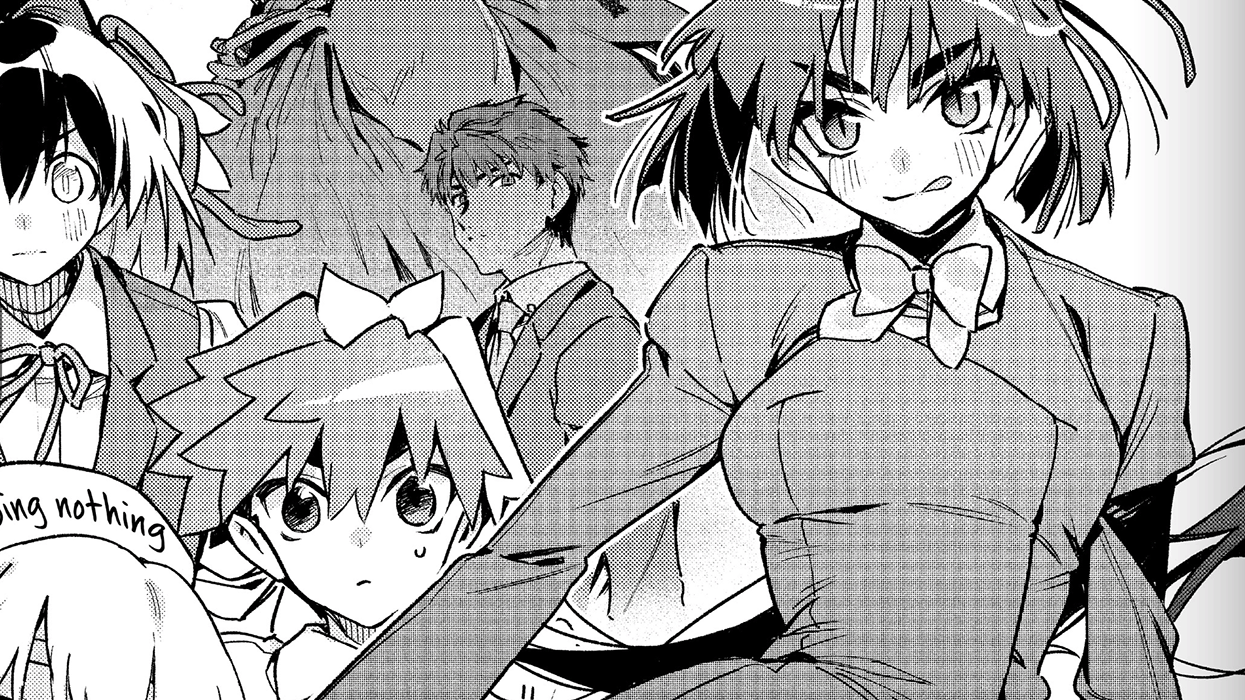
Solution
If it's due to artist or publisher's side, it's not really fixable without redraw. If it's due to screen resolution/DPI,
- The level of moiré can be lowered by using a better image scaling algorithm, such as Lanczos scaling. For example: CDisplayEx (Windows) and Perfect Viewer (Android). You can tweak the Lanczos level in the settings to get better result. The level depends on the
- image DPI of the comic
- screen DPI of the user
- comic reader
- Reading a version downscaled by a third party (aggregators or nyaa uploads with "SD" tag) or manually downscaling them
- Or using a higher resolution and/or bigger display

File Naming
Publisher
The publisher can be mainly two types.
- CaaS(Chapters as a Service): These sites release chapters indvidually instead of volume. Examples: Manga Plus, Manga UP!, Comikey, Tapas etc.
- Volume: Sells the whole volume with better quality. Example: VIZ, Kodansha, Square Enix etc.
Source
Nowadays the primary source is digital, since it's is easier to rip and usually higher quality. In the case of scans, the most used tag is c2c - cover to cover.
Uploader
The ripper of the manga. Sometimes, it can be more than one person too. Also, if the manga is scanlated, the scanlation group is credited here.
f
It indicated this is a fixed version after the initial upload. If there are further fixes, it will be put as f2, f3 etc.
PRE
It indicates that a digital release has issues the publisher has yet to fix (like missing/duplicated pages). PRE2 means the publisher has fixed some of those issues, but not all of them.
Brackets
| Bracket | Use Case |
|---|---|
| () | Manga |
| {} | Manhwa |
| [] | Light Novel |
Format
CBZ is the most common file format for manga. CBZ is just a Zip container. There are also CBR(RAR), CB7(7zip), PDF, ePub etc. The image files inside is generally jpeg and png.